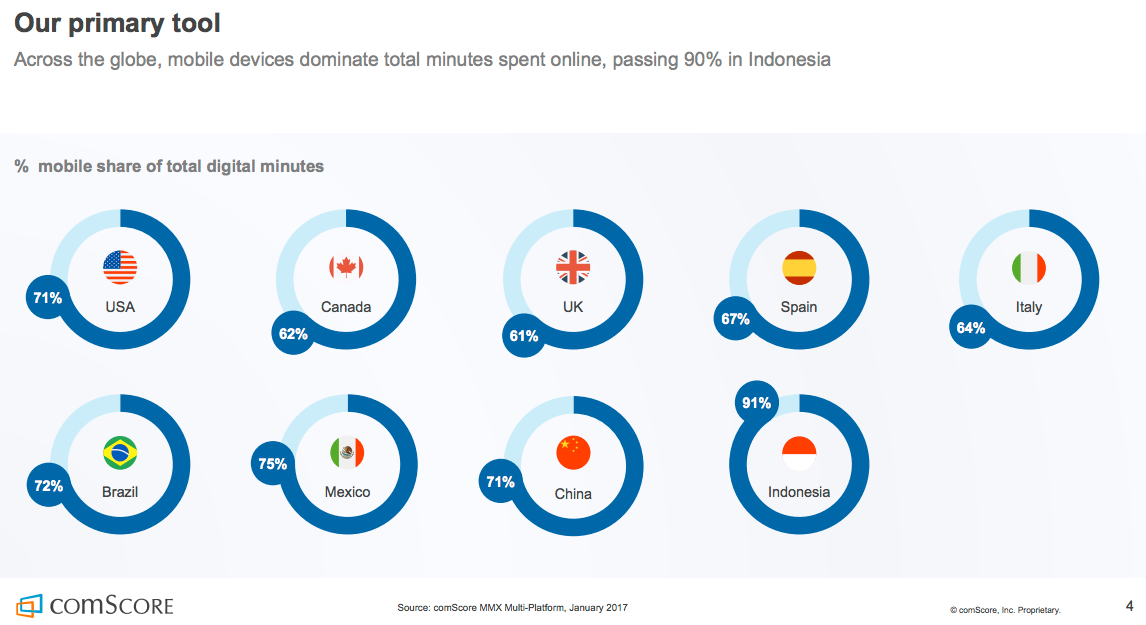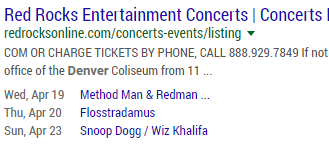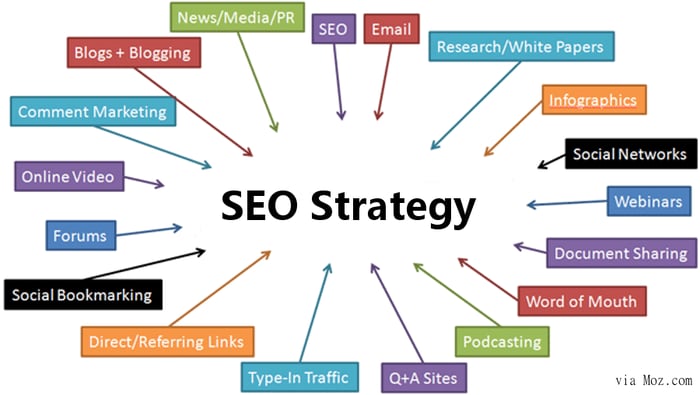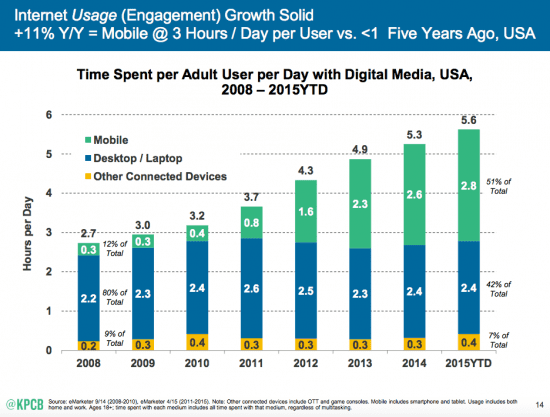You don't have to race to get a medal. You just have to improve. The same applies to your approach for optimizing the search function of your SEO outdoor industry brand strategy
Marathon running, or training for a trail running race involves a lot, and more often than not, the finish line doesn't tell the whole story. The road to reaching your goal is filled with small victories. You plan your workout, execute on your plan, improve your times and celebrate the small victories. However, you must have a plan to monitor your progress.
Similar to training for a marathon, your company's SEO strategy is wide-ranging. The measurements of your success are now associated with search engine rank for relevant keywords. With the right strategy and tools, you will be able to see your progress over time and increase your website's visibility. Growing your outdoor industry brand online requires an SEO strategy.
Read along below, email this article to yourself, bookmark it for later, or jump to the section that interests you most. The sections are:
What is It?SEO as the Backbone of Your Digital Marketing Campaign
Social Does Matter as a Second Tier Ranking Factor
SEO Actually Takes Into Account Whether or Not Your Visitors are Staying on Your Website and Engaging with Other Content
First-Page Ranking Doesn't Mean Guaranteed Success
Search Engine Optimization is Complicated, but Running a Business is Complicated
Creating an SEO Strategy for Your Brand
So, Having Said All That ... What is SEO?
Want to Try It on Your Own?
What's this Analytics Stuff
What is It?
Search Engine Optimization (SEO), Search Engine Results Page (SERP), Pillar Pages, and Keywords. You have heard of all kinds of SEO terms and listened to people talk about how important they are to your outdoor industry brand's success. Simple right? Getting more traffic from Google is a goal. All you need to do is pay someone to figure out the keywords to use in your web landing pages, homepage, and content and you're set. Just like that, you have SEO optimization and you will move to the top of search results. Seems pretty straightforward. High five right?
Wrong.
Many people understand the basic principles of SEO, but a lot has not only changed in the last few years, and the changes are coming at such a rapid rate it takes some dedicated brain bandwidth in your company to keep up. The SEO that we know in 2017 will not be the same SEO in 2018. And that's why the basic question of "What is SEO?" is actually a really important question to continue to ask and answer.
What is SEO success? Check out Neil Patel’s guide to measuring SEO success.
SEO as the Backbone of Your Digital Marketing Campaign
Growing your search engine results can lead to valuable new visits to your website. The more relevant keywords you create and implement on your website, the more it will show up in search results.
Manufacturers and retailers can diagnose, prescribe and fix their own SEO rankings without the help of a SEO services agency. For tips on how to increase your rankings on your own, read this!
SEO isn't about including as many keywords as possible
In the old days, experts would suggest putting in as many keywords as possible in order to optimize your webpages and content. The fact is it did not work in the old days and it does not work today. It can in fact really hurt you SEO because search engines will recognize that as keyword stuffing -- meaning that you include your keywords too many times simply to attempt to rank for a particular keyword.
Today, your keywords should appear in your content in a way that feels natural. Don't force their use. If you feel like you're forcing it, a good rule of thumb is to just leave it out.
SEO is more focused around content topics.
Although building content around keywords and long-tail keywords Before you create a new site page or blog post, you will probably be thinking about how to best incorporate your keywords. This is now the wrong way to think about your keywords. Whenever you create content, your focus should be on content that matters to your audience, not how many times you can include a keyword or keyword phrase in that content.
If you do that, you'll usually find you naturally optimize for important keywords, anyway. Understanding your target audience and what interests them is key to attracting relevant visitors to your website through search engines.
Keyword research is an important step. You will want to get keyword suggestions, determine their ranking difficulty, and then figure out what the monthly search data is for each keyword. You will use all of this to determine the potential for each keyword. This means you will want to keyword research. Here's Moz's guide on how you can do this yourself.
You can use a tool within HubSpot account to conduct keyword research. The HubSpot’s content strategy tool is used to prioritize the topics that actually drive search traffic. This allows you to formulate a well-researched keyword strategy. It not only gives you keyword suggestions and on-page SEO advice in the same place while you are creating blog posts, landing pages, and site pages, it also allows you to build to-do lists to make it easier for you to optimize content for search as you create it.
Social Does Matter as a Second Tier Ranking Factor
Ten years ago, how you played in the social media channel had no impact on your SEO. Now, you need to think about how social strategy fits into the overall SEO strategy puzzle. Search engine algorithms now care about who is finding your content through social search. They care about tweets, what is in the tweets, if the tweets have retweeted, what's in your Instagram image descriptions and are they shared and so on down the line of social media channels which continue to grow.
- "Facebook (81 percent),
- YouTube (71 percent),
- Facebook Messenger (68 percent),
- Google Search (61 percent),
- Google Maps (57 percent),
- Instagram (50 percent),
- Snapchat (50 percent),
- Google Play (47 percent),
- Gmail (44 percent), and
- Pandora (41 percent).
8 out of 10 apps here are owned by Facebook and Google. Users spend 90% of their mobile app time in their top five apps, making up 51% of total digital time spent. Nevertheless, the comScore published its 2017 US Mobile App Report detailing these trends report shows the astonishing influence Facebook and Google have over how US mobile app users spend their time."
Your website visitors' user experience is an important element of SEO.
User experience, user experience, user experience! Mastering the user experience in the world of the ever-changing list of mobile devices is critical, and it is just as important for your SEO strategy as it is for your content strategy. Think of search engine optimization as "user experience optimization." It isn't just important for your users to find your website, it's important for them to stay on your website and interact with your content. It's critical your website is mobile optimized for a mobile user experience because the world is mobile.

The latest data shows that we are now well past the tipping point mentioned at the top of this post. Mobile digital media time in the US is now significantly higher at 51% compared to desktop (42%).
The implications are clear - if you're not able to reach your audience through mobile search or display, or you're not providing a satisfactory mobile experience you will miss out compared to competitors who are mobile only.
SEO Actually Takes Into Account Whether or Not Your Visitors are Staying on Your Website and Engaging with Other Content
Some of the reasons websites don't rank well with Google are:
- They do not create fulfilling, thorough content that addresses searchers' needs improved your chance to earn top rankings.
- People are "bouncing from your site." If a visitor conducts a search and your site comes up in the search results, but that visitor in clicking your first link website, then immediately hits the back button to try the second link, this indicates they were not satisfied with the first result and "bounce" off your site.
- Your website is not very user-friendly. Usability and user experience are second order influences on search engine ranking success. They provide an indirect but measurable benefit to a site's external popularity, which the engines can then interpret as a signal of higher quality.
Remember, attracting a visitor through keywords is meaningless if your content does not actually help them. Think about your visitors and the content they are looking for more than how many people you can attract to your website.
First-Page Ranking Doesn't Mean Guaranteed Success
In the past, SEO success was measured by whether or not you were ranked high on the first page of Google. But even if you ranked well for a term, does that actually mean you're going to see results? Not always.
If you rank well for a keyword that does not accurately describe the products you offer or services, you may indeed, get a lot of traffic, but then your website visitors realize your company is not what they're looking for. Without the right context to the keywords, you're using you won't have the opportunity to convert those visitors to customers. No customers, no money, meaning it's a waste to rank high on a keyword.
Research by HubSpot found that...
"You don't necessarily need to be in the top three slots to be successful. In fact, if you rank well on subsequent pages, you may still have a high clickthrough rate, albeit less traffic. That's great news for marketers who can't seem to bring pages into those top slots or off the second page. We said it before and we'll say it again: The amount of traffic to your page matters less than how qualified that traffic is."
Quality is more important than quantity, especially from an SEO standpoint. Make sure you're not focused on increasing site traffic and creating content for that purpose. Instead, create content that your buyer personas migh find valuable.
Search Engine Optimization is Complicated, but Running a Business is Complicated
Beyond being comfortable with knowing what SEO stands for, many outdoor industry executives have a view of how it works akin to a scene from a Harry Potter movie. Sure SEO is complicated, but it doesn't include any magic, spells, and dark arts (at least, that we know of!). Regardless of its complexities, it's possible to do it right and succeed.
Creating an SEO Strategy for Your Brand
SEO cannot stand alone as your only means of digital marketing, but it is the foundation of any campaign. The keyword strategy helps marketers form everything from the blog content to the social posts that help promote them. The pages that drive the most traffic will be the pillar pages that you should be linking to your content.
Perhaps the most important SEO related task is to gather enough keyword research to feed your content creation efforts. You want to create content using those keywords, the actual search terms people are using, so you can produce content that effectively “answers” that query. Here are the four basics you should include in a SEO strategy.
1) Pillar Page Strategy
Content really matters. Get your content right, and you’ve created a solid foundation to support all of your other SEO efforts. Search engines love new and fresh content. That’s why you want to create content on a regular basis, or update your content as needed.
Google’s algorithms have gotten really good over the years. If you optimize for a specific topic, you will begin to rank for particular keywords that Google knows are related to that topic. In order to implement this new strategy, it is important that we first pick out the most important pages that are going to drive the most traffic. We choose these pages, or pillar content, based off of certain data that can be pulled from Google Analytics, as well as what pages we want to drive a good amount of traffic to on your web site.
Once you have your pillar content determined and have chosen some topics that represent each page, you can begin research to determine some keywords that will be used to optimize those pages. This will give marketers and content creaters some terminology they should be using.

2) Long-tail Keyword Strategy
In order to see if the keywords will drive traffic, make sure you are using the that will be used as blog titles. They must be within the topics and bound to drive traffic. In order to see if the keywords will drive traffic, make sure you are using the correct tools to determine monthly average searches.
Because long-tail keywords are much easier to rank for, you sometimes have a better chance of getting traffic to your blog posts faster than your pillar pages. By linking to those pillar pages within the blog posts, it gives people a chance to click through to that page, and it gives that page another link, creating more link authority which causes a rise in rank.
3) Mobile Responsiveness
Is your website mobile-friendly? Every year, people spend more and more time using their phone or tablet to find information, but many websites are not designed for different screen sizes and load times. Google’s algorithm now takes mobile responsiveness into account. It is important to make sure that your website doesn't take too long to render on a tablet or smartphone of any size.
To optimize your mobile responsiveness even further, Google offers a tool called Accelerated Mobile Pages (AMP). AMP allows your website content to load faster and before any of the image, video, or other interactive elements on the site, which decreases bounce rate. Additionally, depending on the popularity of your article, your organic search listing could be interactive with a featured image, which increases click-through rate.
4) Schema
Schema is a code that goes on your site that can help search engines return more informative results for the users. It can make your search results look more interactive and give users information without them having to click through to the site. Below is an example of Schema from Red Rocks and their concert schedule:

Red Rocks is using Schema to display their schedule for users to easily see upcoming shows. For users, this is exceptionally useful and Google notices this and holds higher priority over some competitors.
Here are some other resources to understand why having an SEO strategy is critical to your outdoor industry brand success are:
- The Relationship Between SEO and Inbound Marketing
- The Future of SEO and What it Means for Inbound Marketing [SlideShare]
Additional insights into some particular SEO tactics can be found in:
Little Known SEO Tactics: Going Beyond On-Page Optimization & Backlinks
So, Having Said All That ... What is SEO?
It's still the same basic concept thing it was ten years ago -- a bunch of strategies that, if you execute them, will help you rank better in search engines and drive traffic. The strategies change because search engines algorithms change and search engines are founded on reflecting how people are actually searching.

Want to Try It on Your Own?
Develop an overall SEO plan- Now that you have a basic understanding of SEO, you can begin to develop a strategy to implement in your company. If you want to move forward on your own, here is a 30-day plan to give you a better sense of how SEO works, how it fits into your strategy, and what tools you can use to measure and report on your efforts.
Keyword research- If you are just interested in learning how to do keyword research, here's a really good resource. It is Backlinko's keyword research guide on mastering the skill to develop your keyword gameplan.
Running a competitor analysis- This is an essential part of defining an SEO strategy. Competitor and keyword analysis go hand in hand, and in many ways, they provide the basis for a solid SEO strategy. Evaluate your actual competitors, and then perform some research on companies that you would aspire to be like.
During your SEO competitor analysis, you’ll need to uncover answers to the following:
- Who are your main competitors?
- What do their traffic levels look like?
- What keywords and phrases are they ranking for?
- What does their backlink profile look like?
- What kind of social media presence have they got?
- What does their content strategy look like?
Here are some resources that will help you to get started:
- How to Conduct a Competitive SEO Audit to Outrank Industry Rivals
- 5 Steps for SEO Competitive Analysis & Research
What's this Analytics Stuff
What's the point of having an online website if you're not tracking how many visits, leads, and customers are coming from it? Analytics are essential to evaluating effectiveness, and Google Analytics tends to be the most popular choice of in terms of analytics packages. (If you're a HubSpot customer, you can integrate Google Analytics with your portal.)
Measurement is essential for implementing successful SEO strategies. You’ll need to track data around things like rankings, referrals, and links in order to analyze your SEO strategy and optimize it for success.
For more on how to configure your Google Analytics for SEO, follow this guide.
Any way you look at, there is no doubt that you need to have search engine optimization strategies implemented for your outdoor industry brand to succeed today.
It's a marathon, not a sprint to develop and execute an effective SEO strategy for your outdoor industry brand. You can do this!
Here Are Some Blogs on SEO You Should Bookmark as a Resource. I Encourage You to Check Them Out
- Revenue River
- Moz
- HubSpot Marketing Blog
- Search Engine Land
- Search Engine Watch
- Backlinko
- Point Blank SEO Blog
- MatthewBarby.com
- SEOnick
- DejanSEO blog
- Builtvisible
If you would like to discuss any of these topics or task with an outdoor industry marketing company, please give me a call.
Ultimate Guide To Ecommerce SEO



